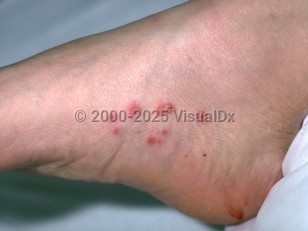Disseminated candidiasis in Infant/Neonate
Alerts and Notices
Important News & Links
Synopsis

Neonatal candidiasis occurs after the first week of life (typically between the second and sixth week) and is acquired via an infected birth canal. It should not be confused with congenital candidiasis, which is acquired in utero and in which skin lesions are present at birth. Neonates predisposed to developing systemic Candida infection include those who are premature and, thus, have a very low birth weight, have received ventilatory support, or have been on intravenous (IV) catheterization for a considerable length of time; have received abdominal surgery; or have received broad-spectrum antibiotics. Systemic candidiasis has now become common among very low birth weight infants in intensive care units, with an incidence of approximately 5%. The incidence decreases as birth weight increases, so that it is less than 1% in average weight newborns.
Multiple organ systems are often affected in candidemia, including the kidneys, with over half of patients manifesting some form of renal involvement, which may include candiduria, hypertension, renal failure, abscess formation, and the development of fungal balls leading to obstruction and hydronephrosis. Central nervous system (CNS) involvement is also frequent, occurring in one-third of cases, and may result in seizures and abscess formation. Premature infants in particular can develop hematogenous Candida meningoencephalitis, in which there is invasion of the CNS by Candida. Endophthalmitis is seen in almost half of all cases.
Half of neonatal patients display skin manifestations. Cutaneous manifestations of systemic Candida infection include a generalized dermatitis, which may be followed by desquamation. Other common skin findings range from discrete pustules and papules to nodules and necrotic skin. Macules may also be present. Systemic symptoms in infants include feeding intolerance, lethargy, temperature instability, apnea, and respiratory distress. Myalgias, arthralgias, and osteoarthritis may be present. Pneumonia occurs in 70% of patients.
Candida auris is an emerging cause of candidemia that is notable for high rates of mortality and for drug resistance. Consultation with an infectious disease specialist is highly recommended when caring for patients with C auris infection.
Codes
B37.7 – Candidal sepsis
SNOMEDCT:
70572005 – Disseminated candidiasis
Look For
Subscription Required
Diagnostic Pearls
Subscription Required
Differential Diagnosis & Pitfalls

Subscription Required
Best Tests
Subscription Required
Management Pearls
Subscription Required
Therapy
Subscription Required
Drug Reaction Data
Subscription Required
References
Subscription Required
Last Updated:09/17/2025

